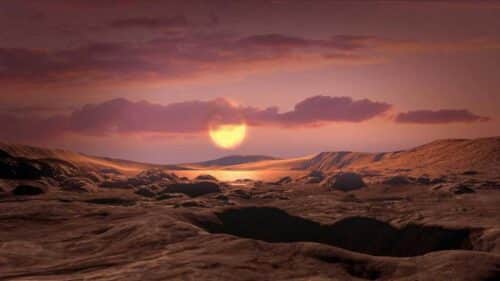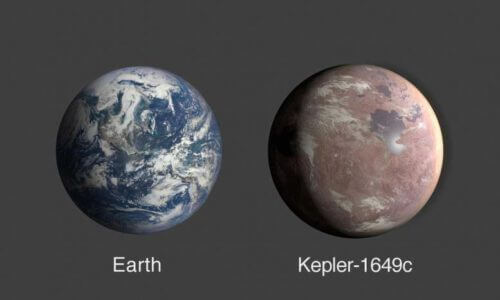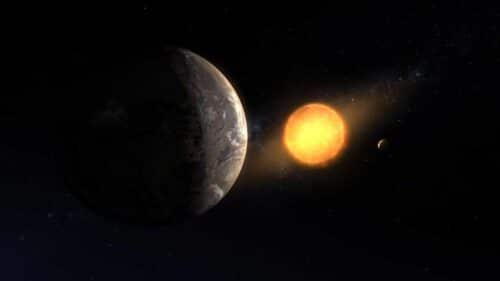Because the star it orbits is much smaller than our sun, it only receives about 75% of the energy but it may still be enough to support life as we know it.

A reanalysis of data from NASA's Kepler space telescope has revealed an Earth-sized planet orbiting its star in the habitable zone, the region where a rocky planet might retain liquid water
An international team of scientists who analyzed archival data of the Kepler space telescope discoveries, discovered an Earth-sized planet orbiting its sun in the habitable zone, the region where a rocky planet might retain water in a liquid state, a feature that is known to be one of the main requirements for the existence of life.
Scientists discovered this planet, called Kepler-1649c, when they looked at old observations from Kepler, which the agency released in 2018. While previous searches using computer algorithms did not detect the planet. Researchers who reviewed the 'Kepler' data took a second look at the star's light signature and identified in it the evidence for the existence of a planet. Of all the planets found by 'Kepler', this planet - located 300 light years from Earth (relatively close to us) is the most similar to Earth in terms of size and approximate temperature on its surface.
This newly discovered planet is 1.06 times larger than our planet but the amount of light it receives from its sun is about 75% of the amount of light Earth receives from our sun. This is because it orbits a red dwarf star. These stars are known for stellar flares that can make the planet's environment hostile to life.
Thomas Zurbotsen, director of NASA's Science Directorate in Washington, said that "this intriguing and distant world gives us even greater hope that a second Earth is among the stars and waiting to be discovered. The data collected by missions like Kepler and its successor TESS will continue to yield amazing discoveries as the science community improves its search capabilities for promising planets year after year."
Not much is known about Kepler-1649c yet, so for example there is no data about the composition of its atmosphere, which may also affect the temperature of the planet. Current planet size calculations also have a significant standard deviation, as do all other astronomical values when considering such distant objects. But based on what is known, Kepler-1649c is of particular interest to scientists looking for habitable planets.
There are other planets that are assumed to be similar in size to Earth, for example TRAPPIST-1f, and according to some calculations also Teegarden c. Others may be more Earth-like in temperature, such as TRAPPIST-1d and TOI 700d. But there is no other planet that is considered more similar to Earth in these two values and which is also in the habitable zone of its system.
Andrew Vanderburgh from the University of Texas, first author of the article published in The Astrophysical Journal Letters. "If we hadn't checked the algorithm's work manually, we would have missed the discovery."

Kepler-1649c orbits the red dwarf so closely that its year is equal to only 19.5 Earth days. In the same system there is another rocky planet of about the same size, but it orbits the star at about half the distance of Kepler - 1649c, similar to how Venus orbits our sun at about half the distance of Earth. Red dwarfs are one of the most common types of stars in the galaxy, meaning planets like this could be much more common than previously thought.
Looking for positive results
'Kepler' looked for planets using the transit method when he observed the stars in one area of the sky and looked for drops in their brightness when the planets passed between them and the Earth.
Most of the time, the changes in light intensity are due to non-planetary phenomena - ranging from natural changes in the star's brightness to other cosmic objects passing by - making it appear as if a planet is there when it is not. The algorithm's job was to distinguish the 12% of the low segments in the star's spectrum graph that were due to real planets from the rest. Those signatures that the algorithm determined came from other sources were considered "false positive" errors.
Due to the sheer number of complex signals, astronomers knew that the algorithm would make mistakes and need to be tested again – a perfect job for Kepler's False Positive False group. This team reviews the algorithm's work, going over any objects classified as false positives, to ensure that they really are mistakes and not planets, thus ensuring that fewer potential discoveries are overlooked, as it turns out happened when the algorithm tagged Kepler - 1649c.
Even as scientists work to further automate analysis processes to extract the most science possible from any given data set, this discovery shows the value of reexamining automated research. Even six years after Kepler stopped collecting data from the original Kepler field – an area of the sky it was directed to from 2009 to 2013, before continuing to explore many other areas – this painstaking analysis has revealed one of the most unique counterparts on Earth yet discovered.
A third planet is possible

Kepler - 1649c is not only one of the planets most similar to Earth in terms of size and energy received from its star, but it gives a completely new perspective on its system. For every nine times that the outer planet in the system orbits the host star, the inner planet orbits almost four times. The fact that their orbits fit together in such a stable ratio indicates that the system itself is extremely stable and likely to survive for a long time.
Near-perfect ratios are often caused by a phenomenon called orbital resonance, but a ratio of nine to four is relatively unique among planetary systems. Usually such resonance comes in two-to-one or three-to-two ratios. Although not yet proven, on rare occasions this ratio may imply the presence of a planet orbiting the exact same star in an orbit midway between the planets, effectively creating a pair of 3:2 resonances.
The team has been looking for evidence of such a third planet but so far without results. However, this may be because the planet is too small to be seen or its orbit is tilted so that it cannot be detected by the transit method used in the Kepler observations.
Either way, this system provides another example of an Earth-sized planet in the habitable zone of a red dwarf. These small, dim stars require planets to orbit them very closely in order to be in the habitable zone - where it is neither too hot nor too cold - so that it can support life as we know it. Although this single example is only one of many, there is growing evidence that such planets are common around red dwarfs.
"As we get more data, we see more signs pointing to the concept that potentially habitable planets similar in size to Earth can be found, even around red dwarfs," said Vanderburgh. "When red dwarfs are almost everywhere in our galaxy, and these small planets that may orbit them, the chance that one of them is not unlike our Earth seems a little higher."
- For more information about 'Kepler' and his discoveries (on the NASA website)
- to NASA's announcement
- for the scientific article
More of the topic in Hayadan:

4 תגובות
Yehuda
You are right - but...
I think it's easier for us to look for a life that is similar to ours, because we know what to look for.
There is another interesting approach that developed in the sixties - mainly by a scientist named James Lovelock. The approach says that life spreads until the planet reaches a stable state. That is - there is an effect of life on an entire planet. For example - the oxygen in our atmosphere is a result of life, therefore the discovery of an "unnatural" atmosphere can indicate the inventions of life.
really close to us In terms of space it is indeed close. In terms of human life it is very far. We will need three life cycles to get there provided we fly at the speed of light. Which probably won't happen. And suppose we get there and discover that the water is not water? But a toxic substance? There are things that are unnecessary to even think about.
There is a mistake in the approach that a life zone is one that is located at an appropriate distance from the sun. The reality of liquid water can be on any planet or moon, regardless of their sun in two other cases:
A. As a result of volcanic activity within the planet itself
B. The existence of a moon near a large planet may create a watery ocean inside the moon - see Jupiter and Europa's moon.
So the pursuit of a suitable distance for the reality of a compatible land is interesting but unnecessary in my opinion. In addition, the experience in our solar system shows a great variety of planets and moons and I find it hard to believe that this will not be the case in other solar systems as well. The reality of liquid water is not only a function of temperature but also atmospheric pressure and more. So all these messages about matching the country we find we have to accept with a very limited guarantee.
That's my opinion.
Good health to everyone in these Corona days!
Please respond gently
Yehuda
Life will go on with or without us.